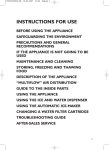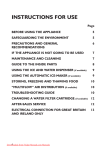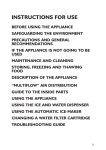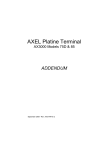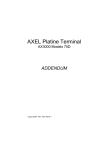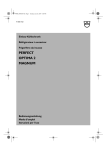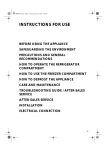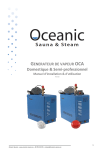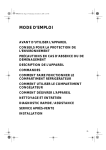Download KitchenAid KRSC 9060 side-by-side refrigerator
Transcript
5019_715_02010_GB_IFU_SbS.qxp 12-03-2007 9:36 Pagina 1 KRSC 9010 Instructions for use 5019_715_02010_GB_IFU_SbS.qxp 12-03-2007 9:36 Pagina 2 5019_715_02010_GB_IFU_SbS.qxp 12-03-2007 9:36 Pagina 3 Before using the appliance 4 Safeguarding the environment 4 Precautions and general recommendations 6 If the appliance is not going to be used 7 Maintenance and cleaning 8 Storing, freezing and thawing food 9 Description of the appliance 10 Control panel description 11 Air Flow 13 Guide to the inside parts 13 Using the appliance 14 Using the ice and water dispenser 17 Using the automatic ice-maker 18 Troubleshooting guide 19 After-Sales Service 22 Electrical connection for Great Britain and Ireland only 23 5019_715_02010_GB_IFU_SbS.qxp 12-03-2007 9:36 Pagina 4 Before using the appliance • Your new appliance is designed exclusively for domestic use. To ensure best use of your appliance, please carefully read the operating instructions which include a description of the product and useful advice. Keep these instructions for future reference. • After unpacking the appliance, make sure it is not damaged and that the door closes properly. Any damage must be reported to the dealer within 24 hours of delivery of the appliance. • Wait at least two hours before switching the appliance on, to ensure that the refrigerant circuit is fully efficient. • Installation and the electrical connection must be carried out by a qualified technician, according to the manufacturer’s instructions and local safety regulations. • Clean the inside of the appliance before using it. Safeguarding the environment 1. Packing The packing material is 100% recyclable and bears the recycling symbol . For disposal, comply with the local regulations. Keep the packing materials (plastic bags, polystyrene parts, etc.) out of the reach of children, as they are a potential source of danger. 2. Scrapping/Disposal The appliance is manufactured using recyclable material. This appliance is marked in compliance with European Directive 2002/96/EC on Waste Electrical and Electronic Equipment (WEEE). By ensuring the correct disposal of this appliance, you can help prevent potentially negative consequences for the environment and the health of persons. The symbol on the appliance, or on the accompanying documents, indicates that this appliance should not be treated as domestic waste but must be taken to a special collection centre for the recycling of electrical and electronic equipment. When scrapping the appliance, make it unusable by cutting off the power cable and removing the doors and shelves so that children cannot easily climb inside and become trapped. Scrap the appliance in compliance with local regulations on waste disposal, taking it to a special collection centre; do not leave the appliance unattended even for a few days, since it is a potential source of danger for children. For further information on the treatment, recovery and recycling of this product, contact your competent local office, the household waste collection service or the shop where you purchased the appliance. Information: This appliance does not use CFC. The refrigerant system contains either R134a (HFC) or R600 (HC). Refer to the rating plate inside the appliance. Appliances with Isobutane (R600a): isobutane is a natural gas without environmental impact, but is flammable. Therefore, make sure the refrigerant circuit pipes are not damaged. 4 5019_715_02010_GB_IFU_SbS.qxp 12-03-2007 9:36 Pagina 5 Safeguarding the environment Declaration of conformity • This appliance has been designed for preserving food and is manufactured in compliance with Regulation (CE) No. 1935/2004. • This appliance has been designed, manufactured and marketed in compliance with: - the safety objectives of Low Voltage Directive 2006/95/CE (which replaces 73/23/EEC and subsequent amendments); - the protection requirements of Directive “EMC” 89/336/EEC amended by Directive 93/68/EEC. Electrical safety of the appliance can only be guaranteed if it is correctly connected to an approved earthing system. 5 5019_715_02010_GB_IFU_SbS.qxp 12-03-2007 9:36 Pagina 6 Precautions and general recommendations INSTALLATION • The appliance must be handled and installed by two or more persons. • Be careful not to damage the floors (e.g. parquet) when moving the appliance. • During installation, make sure the appliance does not damage the power cable. • Make sure the appliance is not near a heat source. • To guarantee adequate ventilation, leave a space on both sides and above the appliance and follow the installation instructions. • Keep the appliance ventilation openings free. • Do not damage the appliance refrigerant circuit pipes. • Install and level the appliance on a floor strong enough to take its weight and in a place suitable for its size and use. • Install the appliance in a dry and well-ventilated place. The appliance is arranged for operation in places where the temperature comes within the following ranges, according to the climatic class given on the rating plate. The appliance may not work properly if it is left for a long time at a temperature outside the specified range. Climatic Class SN N ST T SAFETY • Do not store or use petrol, flammable liquids or gas in the vicinity of this or other electrical appliances. The fumes can cause fires or explosions. • Do not use mechanical, electric or chemical means other than those recommended by the Manufacturer to speed up the defrost process. • Do not use or place electrical devices inside the appliance compartments if they are not of the type expressly authorised by the Manufacturer. • This appliance is not designed for use by young children or the infirm without supervision. • To avoid the risk of children becoming trapped and suffocating, do not allow them to play or hide inside the appliance. • Do not swallow the contents (non-toxic) of the ice packs (in some models). • Do not eat ice cubes or ice lollies immediately after taking them out of the freezer since they may cause cold burns. USE • Before carrying out any maintenance or cleaning operation, unplug the appliance or disconnect it from the power supply. • All appliances equipped with an automatic icemaker and water dispenser must be connected to a water supply that only delivers drinking water (with mains water pressure of between 0.17 and 0.81 Mpascals (1.7 and 8.1 bar)). Automatic ice-makers and/or water dispensers not directly connected to the water supply must be filled with drinking water only. • Use the refrigerator compartment only for storing fresh food and the freezer compartment only for storing frozen food, freezing fresh food and making ice cubes. • Do not store glass containers with liquids in the freezer since they may burst. Amb. T. (°C) Amb. T. (°F) from 10 to 32 from 50 to 90 from 16 to 32 from 61 to 90 from 16 to 38 from 61 to 100 from 16 to 43 from 61 to 110 • Make sure the voltage specified on the rating plate corresponds to that of your home. • Do not use single/multi adapters or extension cords. • For the water connection, use the pipe supplied with the new appliance; do not reuse that of the previous appliance. • Power cable modification or replacement must only be carried out by qualified personnel. • It must be possible to disconnect the appliance from the power supply by unplugging it or by means of a mains two-pole switch installed upstream of the socket. The Manufacturer declines any liability if the above advice and precautions are not respected. 6 5019_715_02010_GB_IFU_SbS.qxp 12-03-2007 9:36 Pagina 7 If the appliance is not going to be used For short vacations • The refrigerator does not have to be disconnected from the power supply if you will be away for less than three weeks. Use up perishable food and freeze other food. • If the appliance has an automatic ice-maker: 1. Switch off the automatic ice-maker. 2. Shut off the water supply to the automatic ice-maker. 3. Empty the bucket. For long vacations • Remove all the food if you are going away for more than three weeks. • If the appliance has an automatic ice-maker: 1. Switch off the automatic ice-maker. 2. Shut off the water supply to the automatic ice-maker. 3. Empty the ice bucket. 4. Fix some wooden or plastic wedges to the upper part of both doors with adhesive tape and leave the doors open enough for air to circulate inside the compartments. This will prevent the formation of mould and bad odours. Moving 1. Remove all the inside parts. 2. Carefully wrap and fix them together with adhesive tape so that they do not knock against each other or become lost. 3. Screw the adjustable feet so that they do not touch the support surface. 4. Using adhesive tape, close and seal both doors and fix the power cable to the appliance. Power failures • In case of a power failure, call the local office of the electricity company to find out how long it is going to last. Note: A completely full appliance will stay cold longer than one that is not. If ice crystals are still visible on the food, it may be frozen again, although the flavour and aroma may be affected. If the food is in poor condition, it is advisable to throw it away. In case of power failures of up to 24 hours 1. Keep the doors of the appliance closed. In this way the stored food will stay cold as long as possible. In case of power failures lasting more than 24 hours 1. Empty the freezer compartment and put the food in a portable freezer. If this type of freezer is not available or no artificial ice packs are available, try to use up the most perishable food first. 2. Empty the ice bucket. 7 5019_715_02010_GB_IFU_SbS.qxp 12-03-2007 9:36 Pagina 8 Maintenance and cleaning • Before any cleaning or maintenance operation, always unplug the appliance or disconnect it from the power supply. • Periodically clean the appliance with a cloth and a solution of lukewarm water and neutral detergent specific for refrigerator interiors. • Never use detergents or abrasives. Never clean the refrigerator parts with flammable liquids. The fumes can cause fires or explosions. • Clean the outside of the appliance and the door seals with a damp cloth and dry with a soft cloth. • Do not use steam cleaners. • Clean the condenser using a vacuum cleaner, proceeding as follows: remove the front kickplate (see installation handbook) and carry out cleaning. Important: • The buttons and control panel display (located on the freezer door on some models) must be cleaned with a dry cloth; do not use alcohol or alcohol-derived substances. • The refrigerant system pipes are located near the defrost pan and can become very hot. Periodically clean them with a vacuum cleaner. Always disconnect the appliance from the power supply before replacing lamps. Replacing the refrigerator compartment top lamp (in some models). 1. Undo the screw fixing the lamp cover. 2. Pull the cover downwards and slide it towards the inside of the refrigerator compartment. 3. Replace the lamp with one of the same type, available from the Customer Care Centre. 4. Refit the lamp cover by carrying out the above operation in reverse order. Replacing the freezer compartment top lamp (in some models). 1. Remove the lamp cover by squeezing the sides. 2. Replace the lamp with one of the same type, available from the Customer Care Centre. 3. Refit the lamp cover by carrying out the above operation in reverse order. Replacing the refrigerator and freezer compartment bottom lamp (in some models). 1. Remove the lamp cover by gripping it in the upper middle part. 2. Pull the lamp cover outwards, at the same time turning it slightly to one side. 3. Remove the blown lamp and replace it with one of the same type, available from the Customer Care Centre. 4. Refit the lamp cover by carrying out the above operation in reverse order. 5. Insert the tabs on one side of the lamp cover in the corresponding grooves. 6. Carefully bend the lamp cover in the middle to insert the tabs on the other side. Replacing the ice dispenser lamp (in some models). 1. Remove the lamp located in the ice dispenser recess. 2. Replace the lamp with one of the same type, available from the Customer Care Centre. 8 5019_715_02010_GB_IFU_SbS.qxp 12-03-2007 9:36 Pagina 9 Storing, freezing and thawing food INTRODUCTION Wrap food so that no water, moisture or condensate can enter; this will prevent odours or aromas going from one part to another in the refrigerator, ensuring better preservation of frozen foods. Use plastic containers with hermetic lids, aluminium trays, aluminium foil, plastic film and waterproof plastic wraps. NOTE: Never place hot food in the freezer. Allow hot foods to cool to room temperature for 30 minutes, then wrap and freeze. Cooling hot foods before freezing saves energy and prolongs the life of the appliance. SEALING When sealing food in bags, remove the air (liquids need space to expand). Fasten the top of the bag with a string. Put the label inside transparent bags; use self-adhesive labels for applying on the outside of opaque bags. DEFROSTING Useful suggestions. - RAW VEGETABLES: place directly in boiling water without thawing and cook normally. - MEAT (large cuts): thaw in the refrigerator compartment without removing the wrapping. Before cooking, leave at room temperature for a couple of hours. - MEAT (small cuts): thaw at room temperature or cook directly. - FISH: thaw in the refrigerator compartment without unwrapping or cook directly before completely thawed. In case of a power failure, the freezer compartment will maintain an adequate storage temperature for about 12 hours; during this period, it is advisable to keep the compartment door closed. Do not refreeze partially thawed food. - ALREADY COOKED FOOD: heat in the oven without removing it from the aluminium containers. - FRUIT: thaw in the refrigerator compartment. FOOD STORAGE CHART Storage times vary according to the quality of the food, the type of packaging or wrap used (moisture and steam proof), and the storage temperature (which must be -18°C). Food category FRUIT Concentrated fruit juice Fruit (in general) Citrus fruit and fresh fruit juices VEGETABLES Commercial frozen Home frozen STEWS Meat, poultry and fish FISH Cod, sole Salmon Mackerel, perch Already seasoned fish Clams, oysters Boiled fish, crabs Raw crayfish Months Food category MEAT Sausages Hamburgers Beef, veal, lamb 12 8-12 4-6 8 8-12 Months 4 weeks or less 1 2-3 ROASTS Beef Veal and lamb Pork Fresh sausages 6-12 6-12 4-6 1-2 STEAK AND CHOPS Beef Lamb, veal, pork 8-12 2-4 2-3 6 2-3 2-3 3 3-4 3-4 12 POULTRY Chicken or turkey (whole or parts) Duck and goose Cooked poultry (in sauce) Steak (without sauce) 9 12 6 6 1 5019_715_02010_GB_IFU_SbS.qxp 12-03-2007 9:36 Pagina 10 Description of the appliance ڹ 훽 훿 훾 FREEZER COMPARTMENT Q. Automatic ice-maker R. Racks S. Bottom basket T. Top basket U. Ice cube bucket V. Freezer door trays W. Freezer door trays X. Inside light REFRIGERATOR COMPARTMENT A. Inside light B. Inside light C. Adjustable shelf D. Shelf - drawer lid E. Drawer F Crisper G. Crisper adjustment H. Meat / vegetable drawer I. Meat / vegetable drawer adjustment K. Dairy products compartment L. 2-litre door tray with bottle holder M. Door trays N. 0.75 litre door tray O. Water filter P. “Multiflow” 10 5019_715_02010_GB_IFU_SbS.qxp 12-03-2007 9:36 Pagina 11 Control panel description Compartments ON / OFF, MENU (browse), selection and confirmation buttons 1 2 3 4 5 1. 2. 3. 4. 5. 6. 6 Freezer compartment temperature control button Refrigerator compartment temperature control button MENU (browse) button Confirmation button Automatic ice maker On/Off button Appliance ON/OFF button Functions and settings symbols Functions and settings for the refrigerator and freezer compartments Appliance, alarm and malfunction symbols Appliance symbols and selection of ice cubes 11 5019_715_02010_GB_IFU_SbS.qxp 12-03-2007 9:36 Pagina 12 Control panel description Functions and settings for the freezer compartment Freezer and/or refrigerator compartment door open “Party” function ON Freezer compartment temperature setting Functions and settings for the refrigerator compartment Fast freeze function Refrigerator compartment temperature setting Fast cooling function Vacation function Appliance, alarm and malfunction symbols Sensor function activated. The appliance is working to reach optimum food storage conditions Control panel locked Alarm symbol, generally in association with an acoustic alarm Malfunction and After-sales Service symbol Functions and settings for the automatic ice maker and water filter Selection of ice cubes or crushed ice Indicates the state of the water filter 12 5019_715_02010_GB_IFU_SbS.qxp 12-03-2007 9:36 Pagina 13 Air Flow “MULTIFLOW” is a ventilated airflow system that ensures an even temperature inside the refrigerator compartment. Food can be arranged on any shelf inside the appliance, taking care not to obstruct the air vents, thus allowing air to circulate freely Guide to the inside parts Removing and repositioning the refrigerator compartment and freezer shelves The shelves can be positioned as required. The glass shelves are strong enough to hold bottles, milk cartons and heavy food, however, take care not to bang products on the shelves. To remove the shelves: pull the shelf out as far as it goes, then lift and remove it. Removing the crisper or meat drawer: 1. slide the drawer out as far as it goes; 2. with one hand underneath the drawer, lift and pull it out; 3. the drawer will come off the runners and can be pulled out further; 4. to remove it completely, the drawer must be turned: front end up, rear end down. Removing the glass drawer lid 1. Lift the front of the frame about 10 cm with one hand, then lift the back of the frame and pull it out with the other. Refitting the glass drawer lid 1. Insert the back of the frame in the supports on the refrigerator compartment walls and lower it into place. Meat drawer temperature control device • The cold air is conveyed inside the meat drawer through an opening between the refrigerator compartment and the freezer compartment. In this way the temperature inside the meat drawer is kept lower than the rest of the refrigerator. The air flow can be adjusted by means of the special slider. • To store vegetables in the meat drawer, shift the control device all the way to the left, to the vegetables setting. This avoids possible damage due to the vegetables freezing. Crisper moisture control device • The control device can be set to any position between minimum and maximum . • In this position , moist air is removed from the crisper to ensure better preservation of fruit and vegetables with peel. • In this position , moist air is kept inside the crisper to ensure better preservation of leafy vegetables. 13 5019_715_02010_GB_IFU_SbS.qxp 12-03-2007 9:36 Pagina 14 Guide to the inside parts Removing the freezer compartment baskets 1. Slide the basket out as far as it goes. 2. Lift the front of the basket to release it from the retainer. 3. Pull out the basket completely. Positioning racks in the freezer compartment (depending on the model) To obtain maximum storage capacity, remove the two bottom drawers and position the racks supplied inside the appliance. Using the appliance FIRST USE Connect the appliance to the water system and power supply (refer to the Installation manual). When connected to the power supply, the display lights up and all the symbols appear for a few seconds. Immediately afterwards, two hyphens flash on the freezer display whereas the appliance display indicates a temperature of 5°C (factory-set). The temperature indicators light up and the acoustic signal remains activated until the optimum temperatures are reached. To switch off the acoustic signal press the OK button. The temperature alarm indicator is automatically deactivated when the freezer or refrigerator compartment reach the required temperature. This takes from 2 to 3 hours. Note: It is not possible to modify or interact with the temperature display functions until the required temperature has been reached. Refrigerator temperature The factory-set ideal temperature is +5°C. The required temperature is automatically displayed. To change the temperature, press the refrigerator button until reaching the required value. The selected temperature flashes and then becomes fixed within 5 seconds. Ice On/Off This function activates/deactivates the automatic production of ice. To activate/deactivate it, press the ice on/off button until the symbol is no longer illuminated. Ice Mode: for further information refer to the section “Using the ice dispenser”. Light The product is equipped with an external light allowing the ice and water dispenser to be used even in the dark. The light can be switched on and off by pressing the button on the control panel or pressing one of the two dispenser levers. The automatic ice-maker and control panel light automatically switch off after dispensing water or ice. The light automatically goes off when the control panel is activated. Menu Use this button to select the various optional functions illustrated in the middle of the control panel. A different option is illuminated each time the button is pressed. OK Use the OK button to confirm any operation or selection and to switch off the acoustic signal. Freezer temperature The factory-set ideal temperature is -18°C. As soon as the freezer compartment reaches the required temperature, it is automatically displayed. This takes from 2 to 3 hours. To change the temperature, press the freezer button until reaching the required value. The selected temperature flashes and then becomes fixed within 5 seconds. 14 5019_715_02010_GB_IFU_SbS.qxp 12-03-2007 9:36 Pagina 15 Using the appliance Standby This function turns off the refrigerator and freezer compartments. To activate the standby function, press the button for 3 seconds. To reset the function, carry out the same procedure until the previously set temperatures are displayed. When the appliance is in standby mode, the light inside the refrigerator compartment is off. Remember that this operation does not disconnect the appliance from the power supply. compartment, depending on where the fault occurred. Note: Call the After-sales Service, specifying the code shown in place of the temperature on the display. Press the OK button to deactivate the acoustic signal. OPERATION SYMBOLS Sensor function Lighting up of the symbols indicates that the appliance is working to reach the optimum storage conditions. The function is automatically activated when: • a large amount of food to be chilled and/or frozen is introduced • the refrigerator and/or freezer door is left open for a long time • a prolonged power failure has occurred and the temperature inside the appliance has increased to values that cannot guarantee correct storage of food. The symbol is briefly animated, after which it remains lit until optimal storage conditions have been automatically restored. ALARMS The display light comes on whenever an alarm situation occurs. The alarm symbol is generally associated with an acoustic signal. To deactivate it, press the OK button. The alarm symbol is activated when: • the appliance is connected to the power supply for the first time • after a long idle period • the freezer compartment temperature is inadequate • the amount of food placed in the freezer exceeds that indicated on the rating plate • one of the doors has been left open for more than 2 minutes Water filter Important: The filter cartridge must be replaced only after F1% is shown on the display. Replace the filter cartridge and press the OK button until the F99% symbol appears. The water filter is located under the freezer compartment door. This symbol indicates the state of the water filter. When the product is purchased, and after its replacement, the symbol corresponding to the filter displays the percentage of F99%, which decreases according to use of the product and the natural depletion of the filter charge. When a new filter is required, for a subsequent replacement, the F10% symbol on the display flashes and an acoustic signal is activated. Press OK to deactivate it. Power failure alarm It is activated when the appliance is disconnected from the power supply or in case of a prolonged power failure that has caused an increase in the freezer compartment temperature. The maximum temperature reached during the power failure flashes on the freezer display. To deactivate the acoustic signal, press the OK button Note: A decrease in the temperature values on the display indicates a higher temperature in the freezer compartment, therefore make sure to check the quality of the food before putting it back in the freezer compartment or consuming it. Door open alarm The door alarm symbol lights up and the acoustic signal is activated when one or both doors of the refrigerator and/or freezer have remained open for more than 2 minutes. Note: Check the door and after closing it press the OK button to deactivate the acoustic signal. Operation alarms This alarm signals a problem in the appliance. In case of operation alarms, alarm indications will also be displayed in the refrigerator or freezer 15 5019_715_02010_GB_IFU_SbS.qxp 12-03-2007 9:36 Pagina 16 Using the appliance Automatic ice-maker control panel lock This function consists of deactivating ice and water dispensing for easier cleaning or to prevent unintentional use. It is set by pressing the Ice Mode and Light buttons at the same time for 3 seconds until the symbol lights up; an acoustic signal confirms activation. To deactivate the function, carry out the same procedure until the symbol goes off. Note: The deactivation function does not disconnect the power to the appliance, ice-maker or light, but simply deactivates the dispenser levers. OPTIONAL FUNCTIONS All these functions are activated by pressing the Menu button. Each press of the button corresponds to a function. Press to activate the required function, then confirm with the OK button. Party mode This function is activated by pressing the menu button until the party mode symbol is displayed. The symbol flashes; press OK to confirm. Use this function to chill drinks inside the freezer compartment. When the function is activated, the symbol is animated. 30 minutes after activation (the time required to chill a 0.75 l bottle without the glass breaking), the symbol flashes, an acoustic signal sounds, the display light comes on and the alarm indicator is lit up and displayed. At this point, remove the bottle and deactivate the function by pressing the OK button Important: Do not leave the bottle inside the freezer compartment longer than the time necessary for chilling. Fast cooling This function must be activated before chilling fresh food. The function is activated by pressing the menu button until the fast cooling symbol appears. The symbol flashes and the refrigerator door lights up on the display; press OK to confirm. The function is automatically deactivated after 6 hours, or manually by repeating the operation. Note: When selecting the required function, the user has 5 seconds to select and then confirm by pressing OK, otherwise it is necessary to start again by pressing the menu button. Control panel lock function This function prevents accidental changing of appliance settings or switching off. To lock the control panel, press the freezer temp and fridge temp buttons at the same time for 3 seconds until the symbol lights up: an acoustic signal confirms activation. To deactivate the function, carry out the same procedure until the symbol goes off. Vacation This function deactivates the refrigerator compartment if the user is going away for some time. The function is activated by pressing the menu button until the vacation symbol appears. The symbol flashes and the refrigerator compartment will not display the temperature; press OK to confirm. To reactivate the refrigerator compartment, repeat the operation. Important: After activating the function, remove perishable food from the refrigerator compartment and keep the door closed, since the refrigerator maintains an adequate temperature for preventing the formation of odours. Important: The “fast cooling” function cannot be activated when the VACATION function is switched on. Fast freezing This function must be activated before freezing fresh food. To activate the function, press the menu button until the fast freeze symbol appears. The symbol flashes and the symbol of the relative door lights up; press OK to confirm. The function is automatically deactivated after 24 hours, or manually by repeating the operation. Ice cube selection This function is used to select the type of ice: crushed or cubes. For further information refer to the section: “Using the ice dispenser”. 16 5019_715_02010_GB_IFU_SbS.qxp 12-03-2007 9:36 Pagina 17 Using the ice and water dispenser Water dispensing When the ice and water dispenser is used for the first time, the first ice cubes and water coming out of the dispenser may have an unpleasant taste and should therefore be discarded. It is advisable to repeat the operation also when the dispenser has not been used for some time. To dispense water press a glass against the water dispenser lever, removing the glass to stop dispensing; at the same time the light inside the dispenser comes on, and goes off when the lever is released. It is not necessary to press hard on the levers to activate the dispenser. Pressing hard will not result in faster dispensing or greater quantities. Wait a few seconds before removing the glass, in order to catch the last few drops of water or pieces of ice. The water and ice dispenser will not work when the freezer compartment door is open. The ice comes from the automatic ice-maker container in the freezer compartment. Ice Mode The function is activated when the symbol is lit. Press the ice mode button to select the symbol corresponding to the type of ice required (cubes or crushed); the symbol will light up. Note: If the freezer compartment door is open, make sure the lever located inside is not blocked, since it prevents the transfer of ice from the automatic ice-maker to the container installed in the door. Normal ice production should be about 7 to 8 batches of ice in a 24-hour period. To dispense ice: 1. press the ice mode button and select the required type of ice. 2. press a rigid glass against the ice dispenser lever. Hold the glass close to the dispenser opening so that ice does not fall outside of the glass 3. press lightly on the lever to activate the ice dispenser. Pressing hard will not result in faster dispensing or greater quantities 4. to stop dispensing, remove the glass slowly so that ice does not fall outside the glass 5. do not use fragile glasses to dispense ice. Using the automatic ice-maker Advice on using the automatic ice-maker If the freezer compartment door is open, make sure to keep the inside flap free, since it serves as a sensor for stopping the transfer of ice from the automatic ice-maker, to the bucket located in the inner door. IMPORTANT: • Large amounts of ice cubes should be taken directly from the bucket, and not from the dispenser • When selecting crushed ice, the cubes are crushed just before being dispensed, therefore the crushed ice may come out with a slight delay. Noise from the ice crusher is normal, and pieces of ice may vary in size. When changing from crushed ice to ice cubes, a small amount of crushed ice may come out together with the first cubes.After switching on the refrigerator, it usually takes overnight for the first ice cubes to form. • When using the water dispenser, keep the rim of the glass near. Move the glass slowly to prevent the water from spilling. To remove and refit the ice bucket: 1. insert four fingers in the opening at the bottom of the bucket and place your thumb on the release button 2. holding the base of the bucket with both hands, press the release button and lift the bucket up and out. It is not necessary to turn the automatic ice-maker control to the OFF position: the automatic ice-maker will not produce ice if the bucket is not installed in the door. 3. Normal automatic ice production consists of about 7 to 9 batches of ice cubes in a 24-hour period. 17 5019_715_02010_GB_IFU_SbS.qxp 12-03-2007 9:36 Pagina 18 Changing a water filter cartridge The water filter is located below the freezer compartment door. 1. Locate the water filter cartridge cap in the front base grille below the freezer compartment door. Rotate the cap counterclockwise to a vertical position and pull the cap and filter cartridge out through the base grille. NOTE: Since there is water in the cartridge, some spilling may occur. 1 2. Remove the cartridge cap by sliding it off the end of the old cartridge. The cap will slide to the left or right. DO NOT DISCARD THE CAP. 3. Take the new cartridge out of its packaging and remove the protective cover from the o-rings. 4. Slide the cartridge cap onto the new cartridge as shown. 5. With cartridge cap in the vertical position, push the new filter cartridge into the base grille until it stops. Rotate the cartridge cap clockwise to a horizontal position. 6. RUN WATER THROUGH THE DISPENSER UNTIL THE WATER RUNS CLEAR (about 9-14 litres or 6-7 minutes). This will clean the system and clear air from the lines. NOTE: as air is cleared from the system, water may spurt out of the dispenser. 2 3 Ordering replacement filters To order more water filter cartridges, please contact your KitchenAid Customer Care Centre. 4 5 18 5019_715_02010_GB_IFU_SbS.qxp 12-03-2007 9:36 Pagina 19 Troubleshooting guide Before contacting the Customer Care Centre... Operation problems are often due to minor causes that can be found and fixed without using any tools. Noises from the appliance are normal, since the fans and compressors for controlling its operation switch on and off automatically. Some noises can be reduced by: • levelling the appliance and installing it on a flat surface • separating and preventing contact of the appliance with the cabinets • making sure the inside parts are correctly positioned • making sure the bottles and containers are not touching each other Some possible operation noises: • hissing when the appliance is switched on the first time or after a long period. • gurgling when the refrigerant enters the pipes. • humming when the water valve or fan are activated. • rattling when the compressor starts up or when the ice drips in the bucket. • a sudden thud when the compressor starts up or stops. When you hear these noises... ...your appliance is alive!!! The appliance does not work: • Is the power cable plugged into a socket powered with the right voltage? • Have you checked the protection devices and fuses of your home’s electrical system? The motor seems to run too much: • Is the condenser free of dust and fluff? • Are the doors properly closed? • Are the door seals intact? • On hot days or when the room is warm, it is normal for the motor to run longer. • If the appliance door has been left open for a long time or if large amounts of food have been introduced, the motor will run longer in order to cool the inside of the appliance. 19 5019_715_02010_GB_IFU_SbS.qxp 12-03-2007 9:36 Pagina 20 Troubleshooting guide If moisture has accumulated: • Make sure the air ducts inside the compartment are not blocked and thus preventing the circulation of air. • Make sure food is properly packaged. Dry any wet food containers before placing them in the appliance. • Make sure the doors are not opened too frequently. When the door is opened, the moisture contained in the room air enters the appliance. The more often the door is opened, the faster moisture accumulates, especially if the room itself is very humid. • If the room is very humid, it is normal for moisture to accumulate inside the appliance. If there is water in the defrost pan: • This is normal in hot and humid weather. The pan can even be half full. Make sure the refrigerator is level so that water does not spill from the pan. If • • • • • the appliance temperature is too high: Are the appliance controls correctly adjusted? Has a large amount of food been placed in the appliance? Make sure the doors are not opened too frequently. Check that the doors close properly. Make sure the air ducts inside the compartment are not blocked and thus preventing the circulation of cold air. If the area in contact with the seal is hot to the touch: • This is normal in hot weather and when the compressor is working. If • • • • the doors do not open and close properly: Make sure no food packages are blocking the door. Make sure the inside parts or the automatic ice-maker are not incorrectly positioned. Make sure the door seals are not dirty or sticky. Make sure the appliance is level. If • • • the light does not work: Have you checked the protection devices and fuses of your home’s electrical system? Is the power cable plugged into a socket powered with the right voltage? Is the lamp burnt? If the automatic ice-maker does not work: • Has the freezer had enough time to become cold? With a new appliance this may take overnight. • Is the automatic ice-maker ON/OFF button set to ON? • Make sure the lever of the automatic ice-maker, inside the freezer compartment, is not turned to OFF, i.e. in the horizontal position (in some models). • Is water reaching the automatic ice-maker? Is the water cock open? The filter may be clogged or not correctly installed. Firstly, check the filter installation instructions to make sure the filter is correctly fitted and not clogged. If installation or clogging is not the problem, call qualified personnel or a technician. If the dispenser does not work: • Is the freezer compartment door closed? • Is the ice bucket correctly installed? 20 5019_715_02010_GB_IFU_SbS.qxp 12-03-2007 9:36 Pagina 21 Troubleshooting guide If the automatic ice dispenser stops working: • Are the ice cubes stuck because the automatic ice dispenser has not been used for some time? Shake the ice bucket to separate the cubes and increase the holding capacity. It is advisable to throw away the old ice cubes and make new ice. • Has the ice dispenser lever been pressed for too long? Wait about 3 minutes for the dispenser motor to reset. Large amounts of ice cubes should be drawn directly from the bucket, and not through the dispenser. If the ice has an unpleasant smell or taste: • Has the ice absorbed bad odours? Is the quality of the water good? It is advisable to make new ice. Throw away the old ice and make new ice. Keep excess ice in a covered container. Water containing minerals may require a filter. • Is the food properly covered? • Is the ice bucket/freezer compartment clean? Follow the instructions for the correct ice dispenser water supply. • Are the pipes correctly connected to the ice dispenser? The first ice cubes coming out of the dispenser may have an unpleasant taste, therefore it is advisable to discard them and make new ice cubes. If the dispenser does not dispense ice when the lever is pressed: • Change the ice selection from cubes to crushed ice, or vice versa, in order to remove any ice blocks. If the dispenser still does not dispense ice, wait a couple of minutes and repeat the operation. If there is condensate in the ice and water dispenser: • Press the corresponding button to activate the anticondensate function. Automatic ice-maker noises (in some models): Since the appliance is equipped with an automatic ice-maker, you may hear a humming sound (coming from the water valve), water trickling and the sound of ice falling into the bucket. Blown lamp: 1. Always unplug the appliance. 2. Refer to chapter “Maintenance and Cleaning” IMPORTANT • If ice is still not dispensed when the lever is pressed, wait a couple of minutes and repeat the operation. • If there is condensate in the ice/water dispenser area, press the corresponding switch (marked with A in the figure) to activate the anticondensate device. If, on pressing the lever, the dispenser does not dispense, change the selection mode from cubes to crushed ice, or vice versa, in order to remove any ice blocks. 21 5019_715_02010_GB_IFU_SbS.qxp 12-03-2007 9:36 Pagina 22 After-Sales Service Before contacting the Customer Care Centre: Switch the appliance on again to see if the problem has been solved. If it has not, switch off the appliance again and repeat the operation after one hour. If your appliance still does not work properly after carrying out the checks listed in the troubleshooting guide and switching the appliance on again, contact the Customer Care Centre on 00800-3810-4026, clearly explaining the problem and specifying: • the type and serial number of the appliance(given on the rating plate). • the type of fault. • the model. • the Service number (the number after the word SERVICE on the rating plate inside the appliance). • your full address • your telephone number and area code. Note: If removal of appliance door is carried out by the Customer Care Centre it is not covered by the warranty. 22 5019_715_02010_GB_IFU_SbS.qxp 12-03-2007 9:36 Pagina 23 Electrical connection for Great Britain and Ireland only Warning - this appliance must be earthed Socket outlet / plug (valid for both countries) If the fitted plug is not suitable for your socket outlet, please contact KitchenAid Service for further instruction. Please do not attempt to change plug yourself. This procedure needs to be carried out by a qualified technician in compliance with the manufactures instructions and current standard safety regulations. Fuse replacement If the mains lead of this appliance is fitted with a BS 1363A 13amp fused plug, to change a fuse in this type of plug use an A.S.T.A. approved fuse to BS 1362 type and proceed as follows: 1. Remove the fuse cover (A) and fuse (B). 2. Fit replacement 13A fuse into fuse cover. 3. Refit both into plug. Important: The fuse cover must be refitted when changing a fuse and if the fuse cover is lost the plug must not be used until a correct replacement is fitted. Correct replacement are identified by the colour insert or the colour embossed in words on the base of the plug. Replacement fuse covers are available from your local electrical store. For the Republic of Ireland only The information given in respect of Great Britain will frequently apply, but a third type of plug and socket is also used, the 2-pin, side earth type. 23 5019_715_02010_GB_IFU_SbS.qxp 12-03-2007 9:36 Printed in Italy 03/07 n 5019 715 02010 GB Pagina 24


























